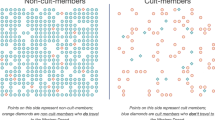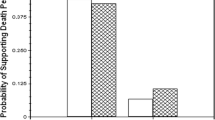Abstract
Two experiments were conducted to study the manner in which civil jurors assess punitive damage awards. Jury-eligible citizens were shown a videotaped summary of an environmental damage lawsuit and told that the defendant had already paid compensatory damages. They were asked to judge liability for punitive damages and, if damages were to be assessed, to assign a dollar award. Three independent variables were manipulated in the case materials: the dollar amounts that were explicitly requested by the plaintiffs in their closing arguments to the jury, the geographical location of the defendant corporation, and the location of the lead plaintiff. Consistent with prior findings of anchor effects on judgments, we found that the plaintiffs requested award values had a dramatic effect on awards: the higher the request, the higher the awards. We also found that local plaintiffs were awarded more than were geographically remote plaintiffs, while the location of the defendant company did not have reliable effects on the awards. The implications of these results for procedures in civil trials and for theories of juror decision making are discussed.
Similar content being viewed by others
REFERENCES
Anderson, M. C., & MacCoun, R. J. (1997). Goal conflict in jurors' assessments of compensatory and punitive damages. Unpublished manuscript, Goldman School of Public Policy, University of California, Berkeley.
Anderson, N. H. (1981). Foundations of information integration theory. New York: Academic Press.
Baldus, D., MacQueen, J. C., & Woodworth, G. (1995). Improving judicial oversight of jury damages assessments: A proposal for the comparative additur/remittitur review of awards for nonpecuniary harms and punitive damages. Iowa Law Review, 80, 1109–11267.
Belli, M. M., Sr. (1980). Punitive damages: Their history, their use, and their worth in present-day society. University of Missouri at Kansas City Law Review, 49, 1–23.
Blatt, R. L., Hammesfahr, R. W., & Nugent, L. S. (1991). Punitive damages: A state by state guide to law and practice. St. Paul, MN: West.
Bornstein, B. H. (1994). David, Goliath, and Reverend Bayes: Prior beliefs about defendants' status in personal injury cases. Applied Cognitive Psychology, 8, 233–258.
B.M.W. v. Gore (1996). No. 94-894, 64 U.S.L.W. 4335 (May 20, 1996).
Cather, C., Greene, E., & Durham, R. (1996). Plaintiff injury and defendant reprehensibility: Implications for compensatory and punitive damage awards. Law and Human Behavior, 20, 189–205.
Chapman, G. B., & Bornstein, B. H. (1996). The more you ask for, the more you get: Anchoring in personal injury verdicts. Applied Cognitive Psychology, 10, 519–540.
Daniels, S., & Martin, J. (1990). Myth and reality in punitive damages. Minnesota Law Review, 75, 1–64.
Daniels, S., & Martin, J. (1995). Civil juries and the politics of reform. Chicago: Northwestern University Press.
Davis, J. H. (1996). Group decision making and quantitative judgments: A consensus model. In E. H. Witte and J. H. Davis (Eds.), Understanding group behavior: Consensual action by small groups (Vol. 1, pp. 35–59). Mahwah, NJ: Erlbaum.
Davis, J. H., Au, W. T., Hulbert, L., Chen, X.-p., & Zarnoth, P. (1997). Effects of group size and procedural influence on consensual judgments of quantity: The example of damage awards in mock civil juries. Journal of Personality and Social Psychology, 73, 703–718.
Diamond, P. (1997). Efficiency effects of punitive damages. Working Paper, Department of Economics, Massachusetts Institute of Technology, Cambridge, Massachusetts.
Diamond, S. S., & Casper, J. D. (1992). Blindfolding the jury to verdict consequences: Damages, experts, and the civil jury. Law & Society Review, 26, 513–563.
Eades, R. W. (1993). Jury instructions on damages in tort actions (3rd ed.). Charlottesville, VA: Michie.
Eisenberg, T., Goerdt, J., Ostrom, B., Rottman, D., & Wells, M. T. (1997). The predictability of punitive damages. Journal of Legal Studies, 26, 623–661.
Eisenberg, T., & Wells, M. T. (1998). Punitive damages after BMW, a new capping system, and the reported opinion bias. Wisconsin Law Review, 1998, 387–425.
Ellis, D. D., Jr. (1982). Fairness and efficiency in the law of punitive damages. Southern California Law Review, 56, 1–78.
Ellis, D. D., Jr. (1989). Punitive damages, due process, and the jury. Alabama Law Review, 40, 975–1008.
Feigenson, N., Park, J., & Salovey, P. (1997). Effect of blameworthiness and outcome severity on attributions of responsibility and damage awards in comparative negligence cases. Law and Human Behavior, 21, 597–617.
Galanter, M., & Luban, D. (1993). Poetic justice: Punitive damages and legal pluralism. American University Law Review, 42, 1393–1463.
Goodman, J., Greene, E., & Loftus, E. F. (1989). Runaway verdicts or reasoned determinations: Mock juror strategies in awarding damages. Jurimetrics Journal, 29, 285–309.
Goodman, J., Loftus, E. F., Miller, M., & Greene, E. (1991). Money, sex, and death: Gender bias in wrongful death damage awards. Law & Society Review, 25, 263–285.
Hans, V. P. (1996). The contested role of the civil jury in business litigation. Judicature, 79, 242–248.
Hans, V. P., & Ermann, M. D. (1989). Responses to corporate versus individual wrongdoing. Law and Human Behavior, 13, 151–166.
Hastie, R. (1991). Is attorney-conducted voir dire an effective procedure for the selection of impartial juries? American University Law Review, 40, 703–726.
Hastie, R., Schkade, D., & Payne, J. (1998). A study of juror and jury judgments in civil cases: Deciding liability for punitive damages. Law and Human Behavior, 22, 287–314.
Hayes, A. S. (1992). Bronx cheer: Inner-city jurors tend to rebuff prosecutors and to back plaintiffs. Wall Street Journal, 1992 (March 24), A1, A6.
Hayes, T. C. (1985). Texaco told to pay 10.5 billion. New York Times, 1985 (November 20), D1.
Himelstein, L. (1994). Jackpots from Alabama juries: A string of mammoth awards has insurers starting to flee. Business Week, 1994 (November 28), 83.
Hinsz, V. B., & Indahl, K. E. (1995). Assimilation to anchors for damage awards in a mock civil trial. Journal of Applied Social Psychology, 25, 991–1026.
Honda Motor Company v. Oberg (1994). 114 S. Ct. 2331.
Huber, P. W. (1988). Liability: The legal revolution and its consequences. New York: Basic Books.
Huber, P. W. (1989). No-fault punishment. Alabama Law Review, 40, 1037–1051.
Jaynes, G. (1995). Where the torts blossom. Time, 1995 (March 20), 38–40.
Jeffries, J. C., Jr. (1986). A comment on the constitutionality of punitive damages. Virginia Law Review, 72, 139–158.
Kahneman, D., Schkade, D., & Sunstein, C. R. (1998). Shared outrage and erratic awards: The psychology of punitive damages. Journal of Risk and Uncertainty, 16, 47–84.
Kerr, N. L., MacCoun, R. J., and Kramer, G. P. (1996). Bias in judgment: Comparing individuals and groups, Psychological Review, 103, 687–719.
Landsman, S., Diamond, S., Dimitropoulos, L., & Saks, M. J. (1998). Be careful what you wish for: The paradoxical effects of bifurcating claims for punitive damages. Wisconsin Law Review, 1998, 297–342.
MacCoun, R. J. (1996). Differential treatment of corporate defendants by juries: An examination of the “deep pockets” hypothesis. Law & Society Review, 30, 121–161.
Mahoney, R., & Littlejohn, S. (1989). Innovation on trial: Punitive damages versus new products. Science, 246, 1395–1400.
Malouff, J., & Schutte, N. S. (1989). Shaping juror attitudes: Effects of requesting different amounts in personal injury awards. Journal of Social Psychology, 129, 491–497.
Moller, E., Pace, N. M., & Carroll, S. J. (1997). Punitive damages in financial injury cases. Santa Monica, CA: RAND.
Nagel, S., & Weitzman, L. J. (1972). Sex and the unbiased jury. Judicature, 56, 108–117.
Note: An economic analysis of the plaintiff's windfall from punitive damage litigation. (1992). Harvard Law Review, 105, 1900–1919.
Ostrom, B. J., Rottman, D. B., & Goerdt, J. A. (1996). A step above anecdote: A profile of the civil jury in the 1990s. Judicature, 79, 233–241.
Owen, D. G. (1982). Civil punishment and the public good. Southern California Law Review, 56, 103–121.
Owen, D. G. (1994). A punitive damages overview: Functions, problems, and reform. Villanova Law Review, 39, 364–413.
Payne, J. W., Bettman, J. R., & Luce, M. F. (1997). Behavioral decision research: An overview. In M. H. Birnbaum (Ed.), Measurement, judgment, and decision making (pp. 303–359). San Diego, CA: Academic Press.
Peterson, M., Sarma, S., & Shanley, M. (1987). Punitive damages: Empirical findings. RAND Report No. R-3311-ICJ. Santa Monica, CA: RAND.
Polinsky, A. M. (1997). Are punitive damages really insignificant, predictable, and rational? Journal of Legal Studies, 26, 663–677.
Polinsky, A. M., & Shavell, S. (1998). Punitive damages: An economic analysis. Harvard Law Review, 111, 869–962.
Priest, G. L. (1996). Punitive damages reform: The case of Alabama. Louisiana Law Review, 56, 825–840.
Quayle, D. (1994). Standing firm: A vice-presidential memoir. New York: HarperCollins.
Raitz, A., Greene, E., Goodman, J., & Loftus, E. F. (1990). Determining damages: The influence of expert testimony on jurors' decision making. Law and Human Behavior, 14, 385–395.
Rosen, J. M. (1997). $3.5 billion for a rail fire. New York Times, 1997 (September 14), D2.
Ross, L., & Nisbett, R. E. (1991). The person and the situation. New York: McGraw-Hill.
Rubin, P. H., Calfee, J. E., & Grady, M. F. (1997). BMW v. Gore: Mitigating the punitive economics of punitive damages. In H. Demsetz, E. Gelhorn, & N. Lund (Eds.), Supreme Court economic review (Vol. 5, pp. 179–216). Chicago: University of Chicago Press.
Rustad, M., & Koenig, T. (1993). The historical continuity of punitive damages awards: Reforming the tort reformers. American University Law Review, 42, 1284–1304.
Saks, M. J. (1992). Do we really know anything about the behavior of the tort litigation system—and why not? University of Pennsylvania Law Review, 140, 1147–1292.
Saks, M. J., Hollinger, L. A., Wissler, R. L., Evans, D. L., & Hart, A. J. (1997). Reducing variability in civil jury awards. Law and Human Behavior, 21, 243–256.
Sales, J. B., & Cole, K. B., Jr. (1984). Punitive damages: A relic that has outlived its origins. Vanderbilt Law Review, 37, 1117–1172.
Schmit, J. T., Prichett, S. T., & Fields, P. (1988). Punitive damages: Punishment or further compensation? Journal of Risk and Insurance, 55, 453–466.
Schwartz, V. E., & Behrens, M. A. (1993). Punitive damages reform—State legislatures can and should meet the challenge issued by the Supreme Court of the United States in Haslip. American University Law Review, 42, 1365–1391.
Schwartz, V., & Magarian, L. (1990) Challenging the constitutionality of punitive damages: Putting rules of reason on an unbounded legal remedy. American Business Law Journal, 28, 485–498.
Shanley, M. G., & Peterson, M. A. (1987). Posttrial adjustments to jury awards. Santa Monica, CA: RAND.
Slap, A. J., & Milstein, A. C. (1989). Punitive damages in toxic tort actions. Trial, 1989 (November), 85–91.
Snyder, E. C. (1971). Sex role differential and juror decisions. Sociology and Social Research, 55, 442–448.
Solomon, C. (1994). Exxon is told to pay $5 billion for Valdez spill. Wall Street Journal, 1994 (September), A1.
Stevens, S. S. (1975). Psychophysics: Introduction to its perceptual, neural, and social prospects. New York: Wiley.
Sunstein, C. R., Kahneman, D., & Schkade, D. (1998). Assessing punitive damages. Yale Law Journal, 107, 2071–2153.
Thomas, E. A. C., & Parpel, M. (1987). Liability as a function of plaintiff and defendant fault. Journal of Personality and Social Psychology, 53, 843–857.
Tourangeau, R., & Rasinski, K. A. (1988). Cognitive processes underlying context effects in attitude measurement. Psychological Bulletin, 103, 299–314.
Turner, J. C., Oakes, P. J., Haslam, S. A., & McGarty, C. (1994). Self and collective: Cognition and social context. Personality and Social Psychology Bulletin, 20, 454–463.
Tversky, A., & Kahneman, D. (1974). Judgment under uncertainty: Heuristics and biases. Science, 185, 1124–1131.
TXO Prod. Corp. v. Alliance Resources Corp. (1993). 113 S. Ct. 2711.
U.S. v. Koon, No. 92-686 (C.D. Cal. Aug. 4, 1993) (Sentencing Memorandum).
Vidmar, N., Lee, J., Cohen, E., & Stewart, A. (1994). Damage awards and jurors' responsibility ascriptions in medical versus automobile negligence cases. Behavioral Sciences and the Law, 12, 149–160.
Wilson, T. D., Houston, C. E., Etling, K. M., & Brekke, N. (1996). A new look at anchoring effects: Basic anchoring and its antecedents. Journal of Experimental Psychology: General, 125, 387–402.
Author information
Authors and Affiliations
Corresponding author
About this article
Cite this article
Hastie, R., Schkade, D.A. & Payne, J.W. Juror Judgments in Civil Cases: Effects of Plaintiff's Requests and Plaintiff's Identity on Punitive Damage Awards. Law Hum Behav 23, 445–470 (1999). https://doi.org/10.1023/A:1022312115561
Issue Date:
DOI: https://doi.org/10.1023/A:1022312115561




